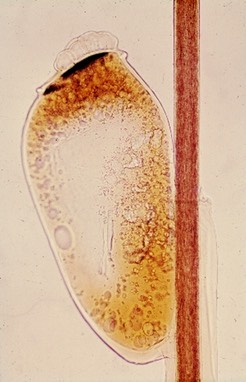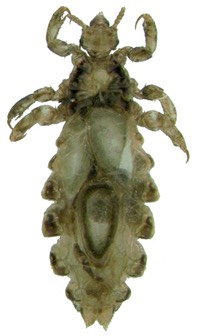Head lice (Pediculus capitis) are small parasitic insects exquisitely adapted to living mainly on the scalp and neck hairs of their human hosts. Their six impressive legs are elegantly evolved to grasp hair shafts, and provide a striking example of biological specialization. Long associated with people, head lice have been recovered from prehistoric mummies. Head lice are equal opportunity parasites; they do not respect socio-economic class distinctions. Their presence does not connote a lack of hygiene or sanitation practiced by their host. Head lice are mainly acquired by direct head-to-head contact with an infested person's hair. Despite commonly held beliefs to the contrary, inanimate objects (such as combs, brushes, hats, helmets, headphones and hair accessories) are insignificant in harboring or transmitting head lice or their eggs. Hence, there is little, if any, reason to focus efforts to clean the home or to bag clothing, toys or other items with the intent of reducing the transmission of head lice.
Head louse infestations are far more frequent amongst children than adults. In North America and Europe, Caucasians are far more frequently infested than are people from other ethnic / racial groups. Furthermore, the prevalence of infestations is far lower in North America than in many other regions of the world.
Neither able to fly nor jump, lice are also unlikely to wander far from their preferred habitat. Lice and their eggs are unable to burrow into the scalp. Lice are sometimes referred to ascooties, eggs asnitsand infested people aslousy. The infestation by lice is termed pediculiasis, and the associated “disease” (if any) pediculosis. Delousing (more properly termed lousing) consists of any method for eliminating an infestation. Chemical treatments directed against lice are pediculicides sometimes misspelled as pediculocides). Those that kill adult and nymphal lice are sometimes called lousicides; those that kill the developing embryo within the egg are ovicides. This text relates to head lice unless specific mention is made to another kind of louse.
Head lice derive nutrient by blood-feeding several times every day, and do so only from a human being. They neither feed upon nor infest other kinds of animals. Once separated from their human hosts, head lice rapidly suffer from starvation and water loss. Such displaced lice generally die in less than one day. A nymphal (immature) louse hatches from its egg after about 8 days of embryonic development. It then begins to feed, grow and develop until it attains the adult stage about 9 days after hatching, and may become an adult male or female. The female louse may produce about six eggs each day until she succumbs to old age in about a month. Only those eggs deposited by inseminated female lice will hatch. Generally, an infested person has fewer than a dozen active lice on the scalp at any time, but may have hundreds of viable, dead and hatched eggs. Rarely, populations of head lice may flourish on a few individuals. In such cases, hundreds of live lice may be present simultaneously.
With adequate magnification, the developing nymph can be seen within the egg ;hatched eggs are nearly transparent. Refer to our photos and images accompanying this site.
Generally, treatment should be considered only when a live or crawling louse is observed. The identity of the crawling insect [as a head louse] on the hair should be positively confirmed. Many other kinds of insects may climb upon or accidentally become lodged amongst the head hair. Frequently, these include plant-associated insects such as aphids and thrips, other garden creatures such as springtails, or common household denizens such as book lice. Because these other kinds of insects do not infest a person; they do not require treatment.

Often, presumed cases of head louse infestations are based upon the discovery of louse eggs (‘nits’) or egg-like material. Without magnification and suitable expertise, they are difficult to correctly distinguish from other material caught in the hair. Amongst presumed ‘nits’ submitted to us by physicians, nurses, teachers and parents, the vast majority are simply artifacts such as dandruff, hairspray droplets, scabs, dirt, or other insects. None of these would justify treatment for head lice.
Itching of the scalp, or the perception that something is crawling on the head, do not necessarily suggest that head lice are present, and they do not warrant treatment for lice.
We provide rapid, expert and confidential services to identify creatures you suspect to be head lice. You may submit actual specimens or digital images to us.
To learn more about our services or to submit a specimen for evaluation click here.
To confirm the identity of suspected material, save a few lice and louse eggs under clear tape on our manual specimen submission form, record the requested information and send us the form along with your sample.
We provide more information about the biology and management of head lice in the FAQs section of this website and we also offer a discussion about other kinds of lice as well.

